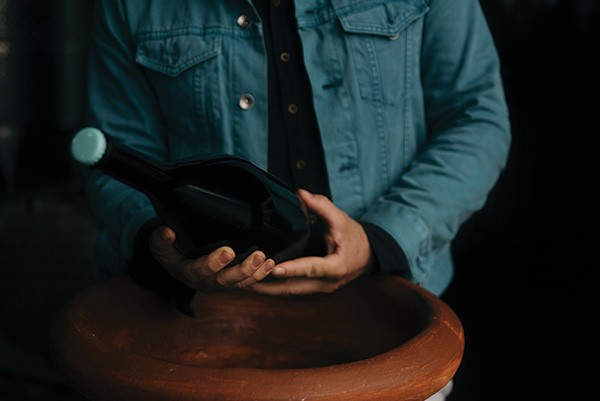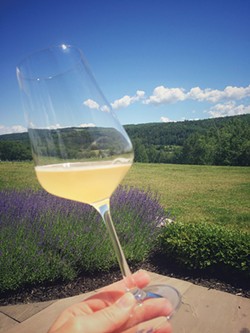It sounds like the most natural thing in the world.
"You're harvesting grapes, pressing them in whole clusters, letting the juice sit, and the ferment starts," explains Bruce Ewert. "When the sugar gets to a level that I know would produce bubbles, it's bottled."
And that's it?
"And that's it."
Ewert,
"It's risky," says Ewert. "Doing a wild ferment…there's possibilities of organisms competing," disturbing the desired fermentation, which relies only on yeast that collects naturally on the grapes and in the vineyard and winery environment.
Nova Scotian winemakers have been crafting elegant, precise sparkling wine in the labour-intensive style of Champagne for 15 years, and now they are trying something different, concocting a small quantity of commercially available Pét-Nat for us to sample. L'Acadie Vineyards' Pét-Nat—a 2017 vintage made from estate l'Acadie Blanc—will be available early June.
Pétillant Naturel is a sub-category of
"It's fun to experiment with a traditional style," says Benjamin Bridge assistant winemaker Alex Morozov. The Gaspereau Valley sparkling wine house will release its 2017 Pétillant Naturel, made from Geisenheim, in early July. "Winemakers are making it for themselves."
Pét-Nat traps in a bottle the whole process of making wine. Because it does so in wine's simplest form, with nothing added (no yeast, sugar or preservatives) and nothing
Natural or low-intervention wine is made from grapes that have been farmed organically, biodynamically, or with the intention to emulate one of the two. Nothing is added at the time of harvest and crush, and indigenous yeasts do the fermenting. The wine is never filtered or fined—the process of using proteins or clays to strip suspended sediment to make wine look and taste cleaner—so
Natural wine has attracted critics who challenge the word "natural," a descriptor regularly co-opted in food marketing that has come to mean nothing, and who question the lack of regulation in low-intervention winemaking. Instead of rules, natural wine demands of winemakers an instinctual sense of their land, fruit and equipment, and to be focused, and restrained.
Ewert, who has been making wine for more than 30 years, puts it this way: "You have to know a lot to do little."
The team at Benjamin Bridge describe a similar balance of scrutiny and giving up control. Keltie MacNeill, Benjamin Bridge Club manager, shows pictures of the daily measurement of Pét-Nat's specific gravity—evaluating its alcohol content before bottling so carbonation doesn't get out of control.
Chris Campbell, production manager, compliments the work of vineyard manager Scott Savoy. "You couldn't make good wine with shitty fruit. You need balance in the vineyard."
And in the vineyard, "no more mowing and being pristine," says MacNeill.
"But plant health doesn't just happen because you want it to," says Campbell.
MacNeill adds, "We're becoming sure of our terroir…"
"…And with knowledge of self, then we can diverge, take the next steps," finishes Campbell, explaining how the winery takes the leap from clean, exact traditional method bubbly to Pét-Nat, a style that defies precision.
Heather Rankin, sommelier, wine judge and owner of Obladee, A Wine Bar, describes a similar leap to natural wine, one required of those at the receiving end of the industry.
"Our customers are
It's also harder to like.
"There's an absence of stuff that makes it tasty," says Rankin. Natural wine "is less rounded out,
She thinks for a moment.
"It's like eating raw chocolate versus a Mars bar."
Rankin carries natural wines at Obladee mostly as "an educational tool, an explorative mechanism… If we can explain what it is, people are interested."
It is understandable that a wine bar would list products representing the latest fad, even if they're harder to sell. But a conversation with Rankin reveals there's more at stake.
"It's no different than eating better food, knowing I'm consuming a more healthful product," she says. "What I like most about natural wine is the transparency aspect," citing the culture that natural winemakers reveal everything they put in their wine—which is not much, considering the 200-odd additives now used in wine.
"The added benefits are supporting sustainable agriculture, and, because at the moment
And anyway, Rankin doesn't believe natural wine is a fad.
"It's not a trend. We're in the process of reshaping wine. Like slow food, it's here to stay."
And luckily, Nova Scotians who want to make a move toward natural wine
"Local Pét-Nats are accessible, due to the types of grapes here," she says. "Our hybrid grapes have fruity, aromatic compounds that rend themselves to the style. The fruit is still toned down, but very nice."
Benjamin Bridge's 2017 Pétillant Naturel is indeed very nice, clearly pronouncing fruit and honey through a strong acid accent. Layers of fruit sweetness and lees add fullness to the wine that prickles the tongue with slight effervescence. Just delicious.
The emergence of natural wine in Nova Scotia may begin to demand of us the same care that it requires of its makers. This means asking questions about how grapes are farmed, what is added to and taken away from wine and how it is handled and stored.
"What are the winemaking and growing philosophies?" Rankin suggests we
"There has to be a real human being behind that wine."
And underneath the human, reminds Ewert, there's earth.
"It's really about terroir, encouraging living soil, for us, seabed soil," he says. "All those beautiful flavours are there."



